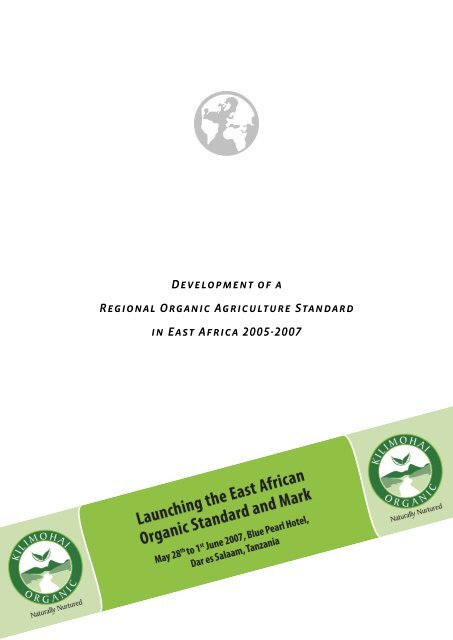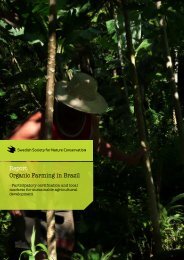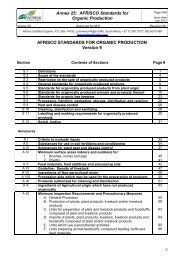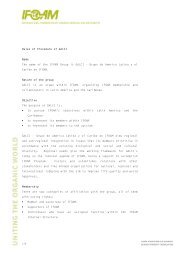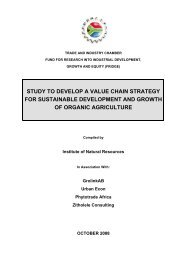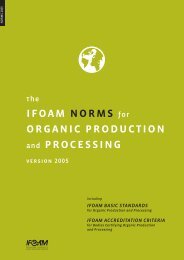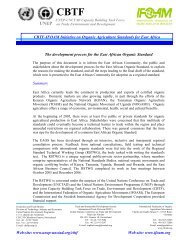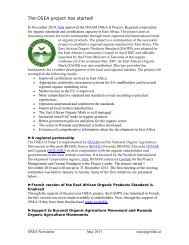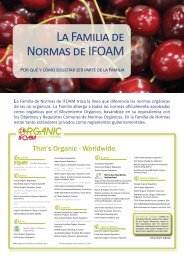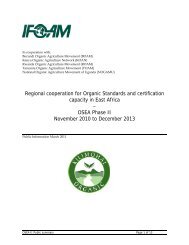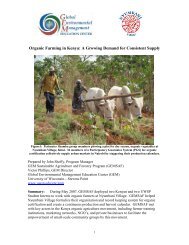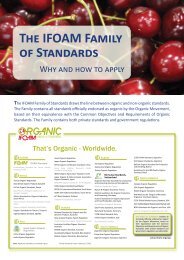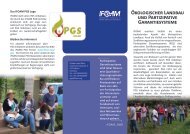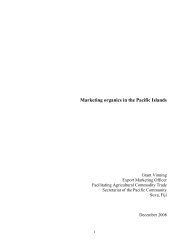OSEA I Project Report - ifoam
OSEA I Project Report - ifoam
OSEA I Project Report - ifoam
You also want an ePaper? Increase the reach of your titles
YUMPU automatically turns print PDFs into web optimized ePapers that Google loves.
DEVELOPMENT OF A<br />
REGIONAL ORGANIC AGRICULTURE STANDARD<br />
IN EAST AFRICA 2005-2007
DEVELOPMENT OF A REGIONAL ORGANIC AGRICULTURE STANDARD IN EAST AFRICA 2005-2007<br />
TABLE OF CONTENTS<br />
EXECUTIVE SUMMARY 4<br />
ACRONYMS AND TERMS USED 5<br />
ACRONYMS 5<br />
TERMS 5<br />
SCOPE OF THIS REPORT AND ACKNOWLEDGEMENTS 6<br />
BACKGROUND 7<br />
ORGANIC AGRICULTURE IN EAST AFRICA 7<br />
STATUS OF ORGANIC STANDARDS AND CERTIFICATION IN EAST AFRICA 2005 9<br />
WHY A REGIONAL STANDARD? 10<br />
DEVELOPMENT OF A REGIONAL STANDARD IN EAST AFRICA 11<br />
THE STANDARD DEVELOPMENT PROCESS 11<br />
THE NATURE AND SCOPE OF THE EAST AFRICAN ORGANIC PRODUCTS STANDARD 14<br />
DEVELOPMENT OF JOINT PROTOCOLS<br />
FOR THE VERIFICATION OF COMPLIANCE WITH THE STANDARDS 15<br />
DEVELOPMENT OF PARTICIPATORY GUARANTEE SYSTEMS 15<br />
DEVELOPING CONSUMER AWARENESS 16<br />
CONSUMER SURVEY 16<br />
EAST AFRICAN ORGANIC MARK 17<br />
DEVELOPMENT OF PROMOTIONAL MATERIALS FOR THE EAOPS AND THE EAOM 19<br />
REGIONAL EVENTS 20<br />
ORGANIC STANDARD FORUM 13 DECEMBER 2006, NAIROBI, KENYA 20<br />
EAST AFRICAN ORGANIC CONFERENCE,<br />
28 MAY TO 1 JUNE 2007, DAR ES SALAAM, TANZANIA 20<br />
RELATED ACTIVITIES AND IMPACTS 22<br />
IMPLEMENTATION 23<br />
PROJECT MANAGEMENT 23<br />
CHALLENGES 23<br />
CONCLUSIONS AND LEARNING POINTS 24<br />
ANNEX 1: KEY ACTIVITIES FOR THE DEVELOPMENT OF<br />
THE EAST AFRICAN ORGANIC PRODUCTS STANDARD 26<br />
ANNEX 2: CONTACTS 28<br />
3
DEVELOPMENT OF A REGIONAL ORGANIC AGRICULTURE STANDARD IN EAST AFRICA 2005-2007<br />
EXECUTIVE SUMMARY<br />
The East African Community encompasses Burundi, Kenya, Rwanda, Tanzania and Uganda<br />
with a combined population of 120 million, a land area of 1.85 million square kilometres and a<br />
combined gross domestic product of $41 billion.<br />
The stakeholders in East Africa developed a regional organic standard in the period 2005 to<br />
2007. This was facilitated by the IFOAM project Regional Cooperation for Organic Standards<br />
and Certification Capacity in East Africa (<strong>OSEA</strong>) and the UNEP/UNCTAD Capacity Building<br />
Task Force on Trade, Environment and Development (CBTF) project Promoting Production and<br />
Trading Opportunities for Organic Agricultural Products in East Africa.<br />
The East African Organic Products Standard was adopted by the East African Community as an<br />
East African standard, which means it became publicly recognized in Burundi, Kenya, Rwanda,<br />
Tanzania and Uganda. In addition, the National Organic Agriculture Movements of Kenya,<br />
Tanzania and Uganda established a common organic mark to be used on organic products in the<br />
region. Other accomplishments were:<br />
– the development of a joint inspection protocol for verification of compliance with the<br />
standard<br />
– concept development for Participatory Guarantee Systems as an alternative way of conformity<br />
assessment<br />
– production of information tools and materials and training of media<br />
Both the mark and the standards were launched in Dar es Salaam, Tanzania by the prime minister<br />
of Tanzania at the East African Organic Conference in May 2007. The launch was attended<br />
by more than 250 people, including the Swedish ambassador, the minister of agriculture of<br />
Tanzania and the minister of trade of Uganda. The <strong>OSEA</strong> project has been a real success both in<br />
its actual accomplishments and in the general boost it has provided to the sector. It has provided<br />
a good foundation for the future development of the organic markets locally, regionally and<br />
internationally. It has also provided the organic sector in East Africa with a common platform<br />
for international negotiations and recognition. Further, a working regional collaboration has<br />
developed on the governmental level, in the form of the East African Community, and between<br />
the national organic agriculture movements around market development and the management<br />
of the East African Organic Mark. A dialogue has also been established between the government<br />
and the private sector on policy.<br />
The experiences in East Africa can provide interesting learning points for other parts of the<br />
world. The whole process has been development-oriented. The standard and the mark are<br />
mainly seen as market-development activities to further the organic sector. Key words have<br />
been facilitation, not control; and inclusion, not exclusion. The consultations about the standards<br />
were extensive at all stages of the process, which made the final products both better and<br />
more acceptable to all.<br />
4
DEVELOPMENT OF A REGIONAL ORGANIC AGRICULTURE STANDARD IN EAST AFRICA 2005-2007<br />
ACRONYMS AND TERMS USED<br />
ACRONYMS<br />
CBTF Capacity Building Task Force on Trade, Environment and Development<br />
EAC East African Community<br />
EAOM East African Organic Mark<br />
EAOPS EAS 456, East African Organic Products Standard<br />
EPOPA Export Promotion of Organic Products from Africa<br />
ICS internal control systems (see explanation below)<br />
IFOAM International Federation of Organic Agriculture Movements<br />
ITC International Trade Center, Geneva<br />
KEBS Kenya Bureau of Standards<br />
KOAN Kenya Organic Agriculture Network<br />
NOAM National Organic Agriculture Movement (KOAN, NOGAMU and TOAM in<br />
the context of this report)<br />
NOGAMU National Organic Agriculture Movement of Uganda<br />
<strong>OSEA</strong> Organic Standards in East Africa<br />
PGS participatory guarantee system (see explanation below)<br />
RSTWG Regional Standards Technical Working Group<br />
Sida Swedish International Development Cooperation Agency<br />
TOAM Tanzania Organic Agriculture Movement<br />
TERMS<br />
Group certification and internal control systems: Group certification is a concept developed<br />
over the last 10 to 15 years to allow producers to organize themselves in groups with an internal<br />
control system, which is then subject to certification by an external body.<br />
Participatory guarantee systems: Participatory guarantee systems (PGS) are systems for certification<br />
that emphasize the participation of stakeholders, including producers. Participatory<br />
guarantee systems share a common goal with third-party certification systems in providing a<br />
credible guarantee for consumers seeking organic produce. The difference is in approach. As the<br />
name suggests, direct participation of farmers and even consumers in the certification process<br />
is not only encouraged but may be required. Active participation on the part of the stakeholders<br />
results in greater empowerment but also greater responsibility.<br />
5
DEVELOPMENT OF A REGIONAL ORGANIC AGRICULTURE STANDARD IN EAST AFRICA 2005-2007<br />
SCOPE OF THIS REPORT AND ACKNOWLEDGEMENTS<br />
What is described here is mainly the accomplishment of the stakeholders in East Africa, in particular<br />
the national organic agriculture movements and a number of committed persons from<br />
NGOs, business and government.<br />
The development of the regional organic standard was coached by the <strong>OSEA</strong> project and the<br />
CBTF project and both shall have equal credit for the accomplishment. There are also other<br />
projects supporting organic in East Africa, particularly the EPOPA programme supported by<br />
Sida and the support to various organic projects by Hivos. Without the work already done by<br />
them, the project would hardly have been successful.<br />
This report has been written to share experiences with others. It therefore lacks the kind of<br />
detail (e.g., details in finances and activities) that is normal for a project report. It is also structured<br />
in a more reader-friendly way than project reports normally are. A detailed project report<br />
is available on request. It also means that some activities are reported that were not a specific<br />
part of the <strong>OSEA</strong> project but were important for the development.<br />
More information about the project, the complete standards and other documents can be found<br />
at http://www.<strong>ifoam</strong>.org/partners/projects/osea.html.<br />
6
DEVELOPMENT OF A REGIONAL ORGANIC AGRICULTURE STANDARD IN EAST AFRICA 2005-2007<br />
BACKGROUND<br />
ORGANIC AGRICULTURE IN EAST AFRICA<br />
The East African Community (EAC) encompasses Burundi, Kenya, Rwanda, Tanzania and<br />
Uganda, with a combined population of 120 million, a land area of 1.85 million square kilometres,<br />
and a combined gross domestic product of $41 billion.<br />
In East Africa the development of the organic sector has been an activity mainly driven by the<br />
private sector, commercial exporters (particularly in Uganda) and NGOs (especially in Kenya).<br />
Production<br />
The numbers of certified producers and farmland under organic agriculture are increasing:<br />
Kenya Farmers: 35,000 Farms: 181,500 ha Companies: 18<br />
Uganda Farmers: 60,000 Farms: 250,000 ha Companies: 34<br />
Tanzania Farmers: 55,000 Farms: 85,000 ha Companies: 31<br />
In Rwanda there is a handful of organic projects and in Burundi one or two.<br />
More operators are investing in organic agriculture, and the products lines are expanding.<br />
Training and Extension<br />
In Kenya there are around 30 NGOs providing training in organic agriculture. Some of them<br />
(e.g., the Kenya Institute for Organic Farming [KIOF]) have already existed for 20 years. There<br />
are also a number of NGOs engaged in training in Uganda and Tanzania. Lately, universities<br />
have shown some interest:<br />
• Sokoine University, Tanzania has a course in organic agriculture.<br />
• There is a summer school with Makerere University, Uganda.<br />
• Uganda Martyrs University has an organic-agriculture degree course.<br />
Extension work has to a very large extent been done by NGOs and (export) companies. The<br />
public extension service has not really been involved in organic agriculture.<br />
Research<br />
There has been very little organic research in the region. Sokoine University has just embarked<br />
on a 20-year trial with FIBL (Switzerland). ICIPE in Kenya does applied research for pest control,<br />
based on organic-agriculture principles.<br />
7
DEVELOPMENT OF A REGIONAL ORGANIC AGRICULTURE STANDARD IN EAST AFRICA 2005-2007<br />
Policy<br />
Governments paid little attention to the sector with a few exceptions. For example, the Uganda<br />
Export Promotion Board has identified organic products as strategic products and the Uganda<br />
Coffee Development Authority has set a target that 10 percent of Ugandan coffee should be<br />
organic. However, in recent years, some policy developments have taken place:<br />
• Uganda has opted for a specific policy for organic agriculture. The draft is at an advanced<br />
stage.<br />
• In Tanzania, organic agriculture has been included in the National Agriculture Policy<br />
which is on review for public comment. It is planned to mainstream organic agriculture<br />
in other agriculture policies such as the livestock policy.<br />
• Kenya opted to mainstream organic agriculture in its Nutrition/Agriculture Policy. Later<br />
it will be included in other relevant policies. It is also possible that a specific organic<br />
policy will be developed.<br />
Market<br />
Most organic products from East Africa are aiming at the export market. Most exports are<br />
made by an exporting company that contracts out-growers. But there are a few cooperatives<br />
exporting (e.g., KCU and KNCU in Tanzania) as well as a few plantations (tea plantations in<br />
Tanzania and Kenya). Among the products for the export market are the following:<br />
• bark cloth<br />
• cashew nuts<br />
• cocoa<br />
• coffee beans<br />
• dried fruits<br />
• essential oils<br />
• fish (sustainable wild fish)<br />
• fresh fruits (bananas, pineapple, passion fruit)<br />
• herbal teas<br />
• herbs<br />
• honey<br />
• instant coffee<br />
• juices<br />
• peanuts<br />
• sesame<br />
• shea nuts<br />
• spices<br />
• vanilla<br />
• vegetables (green beans, etc.)<br />
The main market is the European Union, but exports are also made to the United States as<br />
well as to closer markets in the Gulf and South Africa. A few products, such as dried fruits and<br />
canned pineapples, are processed.<br />
8
DEVELOPMENT OF A REGIONAL ORGANIC AGRICULTURE STANDARD IN EAST AFRICA 2005-2007<br />
The East African market for organic products is relatively small but fast-growing. Some supermarkets<br />
and green groceries are stocking organic products. There are a few dedicated organic<br />
shops and direct marketing schemes (box schemes and farmers’ markets) and sales to restaurants,<br />
hotels, wholesalers and retailers. Most of the initiatives to develop local/national markets are<br />
NGO-supported growers’ groups, private companies and businesses, cooperatives, and organized<br />
producer groups. Sales are mainly fresh produce. Among the processed products are honey, teas,<br />
jams, milk products, dried fruits, mushrooms and oils. Self-claim is the normal form for assurance<br />
about the organic quality, but PGS systems and third-party certification also exist.<br />
Certification<br />
There are two organic-certification bodies in Kenya: AfriCert and EnCert. UgoCert is based in<br />
Uganda and TanCert in Tanzania. EnCert has a clear focus on certification for the domestic<br />
market, while AfriCert is ISO 65 accredited for EurepGap. TanCert and UgoCert are both in the<br />
process of accreditation to ISO 65 and the IFOAM norms. TanCert has agreements with IMO<br />
and bio.inspecta and UgoCert with IMO and Ceres. Both have been supported by the EPOPA<br />
programme, but support is now phasing out and will cease in mid 2008. Certification is also<br />
offered by Europe-based certification bodies such as IMO, Ceres, EcoCert, BCS, Soil Association<br />
and bio.inspecta.<br />
Apart from third-party certification, the national organic agriculture movements, often in cooperation<br />
with NGOs, are implementing guarantee schemes for smallholders along the lines of<br />
participatory guarantee systems (PGS).<br />
STATUS OF ORGANIC STANDARDS AND<br />
CERTIFICATION IN EAST AFRICA 2005<br />
Uganda and Tanzania had already developed private-sector national standards for organic in a<br />
nationwide and participatory process. In Kenya, the Kenya Organic Agriculture Network had<br />
taken up standards development. The Kenya Bureau of Standards had also got engaged and<br />
produced a draft organic standard. In Tanzania the Bureau of Standards had set up a technical<br />
committee. In both Uganda and Tanzania, the Bureau of Standards participated in the initiatives<br />
of the private sector.<br />
Within the Sida 1 funded EPOPA 2 programme, cooperation between organic bodies in Uganda,<br />
Kenya and Tanzania had emerged. The activities were<br />
– a big seminar in Arusha December 2003<br />
– several joint inspection training sessions<br />
– three regional meetings of a working group consisting of two reps from each country<br />
– assistance in the standard development phase<br />
– joint training in certification procedures of certification managers and other staff<br />
On the basis of the background above, IFOAM and the national organic-agriculture movements<br />
(NOAMs) of Kenya (KOAN), Tanzania (TOAM) and Uganda (NOGAMU) agreed to propose<br />
a regional development programme for organic standards and certification cooperation: the<br />
1 Swedish International Development Cooperation Agency<br />
2 Export Promotion of Organic Products from Africa<br />
9
DEVELOPMENT OF A REGIONAL ORGANIC AGRICULTURE STANDARD IN EAST AFRICA 2005-2007<br />
Organic Standards in East Africa (<strong>OSEA</strong>) project. In December 2005 Sida, the Swedish international<br />
development cooperation agency, agreed to support the initiative.<br />
IFOAM has in its activities and engagement a strong focus on Africa, making it natural for<br />
IFOAM to play a coordinating role in these activities. The development of local organic certification<br />
and regional standards fits into the strategic plan of IFOAM, developed by African<br />
stakeholders during 2005. The partner organizations are also IFOAM members.<br />
The <strong>OSEA</strong> <strong>Project</strong><br />
The project was designed as follows.<br />
Overall Objective<br />
To improve the income and livelihood of rural communities in East Africa.<br />
Purpose of the <strong>Project</strong><br />
To improve the income and livelihood of rural communities in East Africa through facilitation<br />
of trade in organic products by means of a regional standard and regional certification<br />
cooperation.<br />
Results of the <strong>Project</strong><br />
1. A draft standard is developed through stakeholder consultations and by field testing<br />
by the end of 2006.<br />
2. Joint protocols for the verification of compliance with standards are developed.<br />
3. A governance structure for the East Africa Organic Standards is established.<br />
4. An East Africa Organic Standard is adopted by early 2007.<br />
5. The East African Organic Standard is approved by IFOAM.<br />
6. Consumers in the East African countries have been informed about the standards and<br />
are increased their understanding of organic agriculture<br />
(Extract from <strong>OSEA</strong> <strong>Project</strong> document)<br />
WHY A REGIONAL STANDARD?<br />
The following are the main reasons for a regional standard (as opposed to national ones):<br />
1. resource use: combining resources is more efficient than letting each country do it by<br />
itself<br />
2. foster cooperation between countries: this leads to better understanding, less conflicts<br />
and a better business climate<br />
3. possibilities for regional trade: a common standard and similar or identical conformity<br />
assessment procedures limit the problems with technical barriers for trade<br />
4. negotiations with other governments for equivalence/recognition: it is easier for a<br />
group of countries to join forces in negotiating with e.g., the European Union than for<br />
each one to do it by itself. It is also easier to get acceptance for adaptations of the standards<br />
if a group of countries argues for them.<br />
5. Coordinating input for Codex Alimentarius and IFOAM. As in the point above, a group<br />
of countries is more likely to be more influential and successful than a country acting<br />
alone.<br />
10
DEVELOPMENT OF A REGIONAL ORGANIC AGRICULTURE STANDARD IN EAST AFRICA 2005-2007<br />
DEVELOPMENT OF A REGIONAL<br />
STANDARD IN EAST AFRICA<br />
In the context of a project of the UNEP/UNCTAD Capacity Building Task Force on Trade, Environment<br />
and Development (CBTF), “Promoting Production and Trading Opportunities for<br />
Organic Agricultural Products in East Africa,” initiated in mid 2005, there was a component<br />
to facilitate the development of an East African Organic Standard. Building on the agreements<br />
already made by the organic stakeholders and including the national standards bodies, the project<br />
convened the Regional Standards Technical Working Group (RSTWG), for its first meeting<br />
in Kampala on 25 October 2005.<br />
Soon thereafter, IFOAM got approval from Sida for the <strong>OSEA</strong> project. CBTF and IFOAM decided<br />
to join forces to most effectively support the development of the East African Organic<br />
Products Standard (EAOPS). The two projects complemented each other well. The CBTF project<br />
had initiated the work and established an appropriate regional structure, and had through<br />
its UN status good access to governments. The <strong>OSEA</strong> project brought additional resources to<br />
conduct national consultations, field-testing of the standard, and the development of a joint<br />
inspection protocol and consumer education. Furthermore, it had the support of networks in<br />
the private sector. The consultants engaged by IFOAM had much experience in the organic sector<br />
in East Africa.<br />
THE STANDARD DEVELOPMENT PROCESS<br />
The development of the standard was based on<br />
– the already existing private sector and public standards in East Africa<br />
– the Codex Alimentarius Guidelines for Organic Production, CAC/GL 32<br />
– the IFOAM Basic Standards<br />
– intensive consultations in the countries, both nationally and regionally<br />
– field testing of the standard<br />
The process was open and transparent and actively engaged a wide variety of stakeholders, in<br />
particular in Kenya, Uganda and Tanzania. As Rwanda and Burundi were not EAC members<br />
at the time of the start of the activities and the project design phase and the organic sector in<br />
those countries was not so well developed, it was not possible to have intensive consultations<br />
in the two countries. However, their representatives in the RSTWG consulted within their own<br />
networks.<br />
The RSTWG met four times between October 2005 and December 2006. Much work was carried<br />
out before and after RSTWG meetings to make the meetings productive and to move the<br />
process forward.<br />
3 The CBTF project’s focus is the development of increased awareness and appropriate policies for<br />
organic agriculture through the process of national integrated assessments in the three countries as<br />
well as background studies and regional workshops and cooperation.<br />
More information at http://www.unep-unctad.org/cbtf/<br />
4 The working name of the standard was East African Organic Standard, while the final name became<br />
the East African Organic Products Standard, a change insisted upon by the bureaus of standards.<br />
11
DEVELOPMENT OF A REGIONAL ORGANIC AGRICULTURE STANDARD IN EAST AFRICA 2005-2007<br />
12
DEVELOPMENT OF A REGIONAL ORGANIC AGRICULTURE STANDARD IN EAST AFRICA 2005-2007<br />
The Regional Standards Technical Working Group (RSTWG)<br />
The RSTWG was a regional public-private sector working group charged with drafting the East<br />
African Organic Products Standard (EAOPS). RSTWG members were representatives of the national<br />
bureaus of standards, the national organic movements, the organic certifying bodies of<br />
Kenya, Tanzania, Uganda, Burundi and Rwanda, and the East African Business Council. It was<br />
co-chaired by a representative of UNCTAD and of IFOAM.<br />
Field Testing<br />
The EAOPS was tested in the field by a group of organic inspectors, between 26 November and<br />
1 December in Uganda, to check how it worked in reality and to identify what was not working.<br />
The field testing also identified gaps in the EAOPS and checked whether it was possible to verify<br />
the standards. In total seven farms and two processors were visited. All relevant standards<br />
were gone through at each place. The outcome was that in general the EAOPS functions well in<br />
the field but the group also gave several proposals for improvement and recommendations to<br />
take away a few standards. The group felt that the field testing was a very useful exercise and<br />
that all new standards should be tested in that way.<br />
Comparison with the IFOAM Basic Standards and Codex Alimentarius<br />
A consultant made a report on the compliance of the EAOPS with the IFOAM Basic Standards<br />
and with the Codex Alimentarius organic guidelines. Most of the EAOPS is in full compliance<br />
with these standards. For some issues, the extent to which the EAOPS complies is a question of<br />
interpretation. For a few standards (e.g., the conversion period), the EAOPS doesn’t comply.<br />
Consultations<br />
The standard consultation process was comprehensive and participatory. Two national consultation<br />
meetings were organized in each country. In addition, the standard was consulted at two<br />
regional meetings (Arusha, March 2006 and Nairobi, December 2006). There were also personal<br />
meetings held with ministries of agriculture, national bureaus of standards and the EAC.<br />
The draft standards were also sent out to a mailing list of around 800 persons. The NOAMs and<br />
others distributed the draft even further.<br />
Final Adoption<br />
In April 2007 the EAOPS was adopted by the EAC as the East African Standard (EAS) 456.<br />
Through the adoption by the EAC it automatically becomes the official standard for the partner<br />
states, and existing public national standards are withdrawn. The private-sector standards (by<br />
KOAN, TanCert, NOGAMU and UgoCert) are also expected to be withdrawn, except for standards<br />
that cover areas not yet within the scope of the EAOPS (e.g., fisheries and aquaculture).<br />
Future Governance<br />
The EAC has its governance structure for standards and its procedures for revision, so there<br />
is a governance structure in place. One concern is that the EAC process lacks funding and the<br />
EAC has a secretariat that is not very strong. Its normal standards-revision procedure is not as<br />
inclusive as the process undergone for the EAOPS. The RSTWG is not a permanent group, but<br />
was dissolved when the EAOPS was approved. However it, or something similar, can be pulled<br />
together when the need arises.<br />
13
DEVELOPMENT OF A REGIONAL ORGANIC AGRICULTURE STANDARD IN EAST AFRICA 2005-2007<br />
THE NATURE AND SCOPE OF THE EAST AFRICAN<br />
ORGANIC PRODUCTS STANDARD<br />
The EAOPS is, for the time being, a voluntary standard, which means that there is no specific<br />
regulation that prohibits producers from claiming a product to be organic even if it is produced<br />
under requirements other than those that are in the standard. Producers wishing to claim that<br />
they follow the standard can do so even if they are not certified.<br />
The East African Organic Products Standard has been written for organic production<br />
in East Africa and has been adapted to conditions in East Africa. The purpose is to<br />
have a single organic standard for organic agriculture production under East African<br />
conditions.<br />
This East African Organic Products Standard has been based on organic standards<br />
currently in place in the region as well as the IFOAM Basic Standards and the Codex<br />
Alimentarius guidelines for the production, processing, labelling and marketing of<br />
organically produced foods.<br />
The East African Organic Products Standard can be used for self-assessment by producers,<br />
declarations of conformity in the marketplace, certification by certification<br />
bodies in the region, and other kinds of verification. If the standard is used for thirdparty<br />
certification, inspection and certification should be carried out in accordance<br />
with international norms, such as ISO Guide 65 or the IFOAM Accreditation Criteria.<br />
If adherence to the standard is verified through other mechanisms, those mechanisms<br />
shall adhere to the principles of competency, integrity and transparency.<br />
The standard is intended for the development of organic production and trade in<br />
East Africa. The standards can be a platform for a common label for organic products<br />
in East Africa and for developing consumer trust. The standard also formulates<br />
standpoints which can be used in international negotiations on standards. Furthermore,<br />
it can be a basis for equivalence agreements with other countries and regions.<br />
The East African Organic Products Standard has been written in a way to make it<br />
easy for the reader and user to access and understand. Because of the need for<br />
organic agriculture to be adapted to local conditions, the standard is not overly<br />
prescriptive. The standard covers plant production, animal husbandry, bee-keeping,<br />
wild production and processing, and products therefrom, regardless of their final<br />
use. In the future, other areas will be incorporated as the need arises (Introduction<br />
to EAS 456).<br />
14
DEVELOPMENT OF A REGIONAL ORGANIC AGRICULTURE STANDARD IN EAST AFRICA 2005-2007<br />
The stakeholders believe that at this point it is best to have a voluntary standard which gives the<br />
sector a joint definition and the possibility of communicating with the consumers on a common<br />
platform. Introducing mandatory organic regulations, such as the EU Regulation for organic,<br />
was not seen as a priority. Such rules, built on mandatory requirements for certification, might<br />
stifle the sector rather than make it prosper. Through credible verification, a joint mark (see<br />
below) and aggressive marketing, the standard will become de facto accepted by all parties.<br />
Currently the standard covers plant production, animal husbandry, bee-keeping, wild production<br />
and processing. It is envisioned that the standard will be expanded to other relevant areas,<br />
such as aquaculture.<br />
DEVELOPMENT OF JOINT PROTOCOLS FOR THE<br />
VERIFICATION OF COMPLIANCE WITH THE STANDARDS<br />
A workshop was held in Arusha, April 2007 with inspectors from UgoCert, TanCert, AfriCert,<br />
EnCert and IMO. The meeting was intended to design common inspection forms and instructions<br />
for their use based on the EAOPS. The purpose was to provide simple tools, but also by<br />
using the same forms convergence of the certification procedures is promoted. A consultant<br />
worked with the results of the workshop and finalized the forms relating to farm production.<br />
This was done in November 2007, so they come into use at the end of the project.<br />
DEVELOPMENT OF PARTICIPATORY GUARANTEE SYSTEMS<br />
Linked to the <strong>OSEA</strong> project, the NOAMs have been developing alternative systems for verification<br />
based on the concept of participatory guarantee systems. IFOAM commissioned a study<br />
on this, and a workshop was held in Arusha in April 2007. It is apparent that for the local and<br />
regional market, there is a need to continue developing these systems.<br />
15
DEVELOPMENT OF A REGIONAL ORGANIC AGRICULTURE STANDARD IN EAST AFRICA 2005-2007<br />
DEVELOPING CONSUMER AWARENESS<br />
CONSUMER SURVEY<br />
A team at KOAN was selected to do the consumer survey in Kenya, Tanzania, and Uganda. The<br />
results were ready in early December 2006 and were presented to the regional Organic Forum<br />
in Nairobi. The purpose of the survey was twofold: to get baseline data for consumer awareness<br />
and attitudes to organic products, and to identify the strategies for increasing the awareness.<br />
The survey of 600 consumers in the major cities of Kenya, Tanzania and Uganda showed that<br />
many don’t know or are not sure about what organic is. Even most of those who say they do<br />
know what organic is were not fully conversant with what organic entails. The following were<br />
the responses to the question “What do you understand by the term organic foods?”<br />
– don’t know or are not sure<br />
Organic food associations<br />
what it means (38 per cent)<br />
Is very nutritious / healthy<br />
– natural foods (26 per cent)<br />
90<br />
Is for the young<br />
80<br />
Is very tasty<br />
– foods without chemicals<br />
60<br />
70<br />
50<br />
(17 per cent)<br />
40<br />
Is for the elite<br />
30<br />
– foods not sprayed with<br />
20<br />
Is safe<br />
pesticides (9 per cent)<br />
10<br />
– traditional or indigenous<br />
0<br />
foods (8 per cent)<br />
Is fashionable / trendy<br />
Is for everyone<br />
– foods grown with manure<br />
(6 per cent)<br />
Is easily available<br />
Is affordable<br />
– herbal foods (3 per cent)<br />
– healthful, nutritious foods<br />
(3 per cent)<br />
Is traditional<br />
The majority of those who are unaware belong to the lower socio-economic classes. Ugandan<br />
respondents scored highest in awareness. It shows that the awareness creation in Uganda is<br />
bearing fruit. This also corresponds to the number of respondents who have heard or seen<br />
advertisements or promotional materials regarding organic food. Consumers identify organic<br />
products with nutritious, tasty and safe food; see the graph.<br />
Total Kenya Tanzania Uganda<br />
Thirty key informants from hotels, shops and restaurants were positive about organic but mentioned<br />
a number of challenges:<br />
• The supply of organic products is very much limited and unreliable.<br />
• Most people do not know or understand much about what organic products are.<br />
• Those who know are few, and amongst these the demand is high, but demand overall<br />
for organic products is low.<br />
• The higher prices of organic products are also a deterrent.<br />
On how their customers verify that the products are organic, most key informants said that<br />
they provide designated places on the business premises for organic products or menus for restaurants<br />
and hotels. When their consumers select from these designated places, they know they<br />
16
DEVELOPMENT OF A REGIONAL ORGANIC AGRICULTURE STANDARD IN EAST AFRICA 2005-2007<br />
are selecting organic products. Others also said that the organic products are clearly labelled as<br />
such while some said that the consumers ask for their guidance on what is organic and what is<br />
not. Most key informants were aware neither of the standards for organic products nor whether<br />
their suppliers had certification. A few whose businesses are solely organic were aware of organic<br />
standards and whether the suppliers were certified.<br />
Key informants were asked to give their opinion on what key issues consumers should be educated<br />
on concerning organic farming. An overwhelming majority said that the consumers simply<br />
need to be educated on what organic farming and products are all about and more so on<br />
what the benefits of consumption are. Most key informants believed that if only more consumers<br />
knew, they would definitely prefer to consume organic products as opposed to non-organic.<br />
This knowledge, they said, would best be imparted through the mass media (radio, TV and<br />
newspapers), and the bearers of this message should be producers, suppliers and manufacturers<br />
with governments also participating, in particular line ministries such as health, trade and<br />
agriculture. Other participants could be NGOs involved in health issues or agricultural issues<br />
or both.<br />
EAST AFRICAN ORGANIC MARK<br />
The <strong>OSEA</strong> meeting in December 2006 agreed in principle to establish an East African Organic<br />
Mark (EAOM), along the following general lines:<br />
• mark to be owned by the NOAMs<br />
• used on products and promotional materials<br />
• used on products produced according to the EAOPS with verification mechanisms accepted<br />
by the NOAMs which can include both third-party certification and PGS<br />
It was agreed that there was an<br />
urgency to establish the mark<br />
so that it could be given a strategic<br />
position in the consumerawareness<br />
and marketing campaigns.<br />
A Kenyan agency was<br />
contracted to develop proposals<br />
for a mark design. They developed<br />
seven proposals based on<br />
instructions from the project.<br />
There were national consultative meetings about the mark and<br />
other market-related issues. All three meetings preferred the same<br />
design. Based on those meetings the designers were given new instructions<br />
to improve the most popular design, and in April 2007<br />
the following mark was agreed among the NOAMs.<br />
17
DEVELOPMENT OF A REGIONAL ORGANIC AGRICULTURE STANDARD IN EAST AFRICA 2005-2007<br />
Establishing the Management Structure for the Mark<br />
Once the design of the mark was agreed upon, a management structure for the mark had to be<br />
established. The structure is based on an agreement between the three NOAMs (it is open to<br />
the participation from Rwanda and Burundi, once they have comparable organizations). The<br />
agreement contains the main things regulating the mark and establishes a management mechanism,<br />
the Joint Management Committee (JMC) for the East African Organic Mark.<br />
Registration of the Mark<br />
Each NOAM registered the mark in its own country. NOGAMU was entrusted with the registration<br />
of the mark in Burundi and Rwanda.<br />
Licensing and Registration<br />
A licensing agreement, to be signed by the users and the respective NOAM, has been drafted.<br />
The mark is provided for a nominal fee to users. A simple registration procedure has also been<br />
developed. In December 2007 there were 15 users of the mark in Kenya, four in Tanzania and<br />
none in Uganda (because of a delay in registration).<br />
The Nature of the East African Organic Mark<br />
The mark should be seen as a promotional tool, the main objective being to create a clear identification<br />
of organic products in the marketplace. Therefore it is open in its construction and<br />
can be used on imported organic products. The mark is not linked to any of the certification<br />
bodies and is therefore available regardless of who has certified the production. It is also not a<br />
“brand” in the normal sense. This means that the mark can be used together with the brand of<br />
the supplier and together with certification marks. All this assists to make the mark useful as a<br />
common mark and communication tool. The ownership with the National Organic Agriculture<br />
Movement means that it is controlled by non-profit independent organizations whose aim is to<br />
promote organic.<br />
18
DEVELOPMENT OF A REGIONAL ORGANIC AGRICULTURE STANDARD IN EAST AFRICA 2005-2007<br />
DEVELOPMENT OF PROMOTIONAL MATERIALS<br />
FOR THE EAOPS AND THE EAOM<br />
Linked to the launch of the EAOPS and the EAOM, a consumer awareness campaign was designed<br />
focusing on the media and the production of materials.<br />
A media training session was conducted for key staff (head and media manager) of the NOAMs.<br />
This was followed up by one-day seminars for selected media in the three countries, where in<br />
total 60 journalists participated. Media briefs were also produced based on IFOAM materials.<br />
The following materials were also produced:<br />
roll up banners<br />
road side banners<br />
posters<br />
brochures<br />
information kits/folders<br />
guidance booklets for the use of the mark<br />
key holders<br />
promotional DVD<br />
stickers<br />
EAOM T-shirts<br />
caps<br />
cotton bags<br />
An organic song, “Kilimohai” (the Swahili word for organic), was produced by the Mionzi Dance<br />
Theatre for the conference in May 2007. The project organized a recording of the song and made<br />
it available to the NOAMs for use in radio programmes and other promotional activities.<br />
The NOAMs made plans for the dissemination of the materials and associated activities and<br />
implemented this. In Kenya the following took place 6 :<br />
• Brochures/folders and posters were distributed to training organizations and NGOs<br />
throughout Kenya. They were also distributed during the farmers’ markets as well as<br />
national trade fairs. Some were taken to the ministry of agriculture’s organic desk.<br />
• T-shirts and bags: These were strategically given to the staff of outlets selling organic<br />
produce and also during the organic farmers’ markets.<br />
• EAOPS was also distributed to training institutions and NGOs working with farmers.<br />
They were also issued during the meeting organized by KOAN to popularize the<br />
EAOPS.<br />
• The roll up banners were issued to organic outlets.<br />
• Key holders and DVDs were given out during events (workshops, farmers markets,<br />
training programmes).<br />
• Stickers were issued to outlets.<br />
• There were two adverts in the press linked to the Dar event.<br />
6 Similar activities were also carried out in Uganda and Tanzania.<br />
19
DEVELOPMENT OF A REGIONAL ORGANIC AGRICULTURE STANDARD IN EAST AFRICA 2005-2007<br />
REGIONAL EVENTS<br />
Three main regional events, co-organized with the CBTF and other partners, were used to raise<br />
awareness and consult with stakeholders. The first one was in Arusha Tanzania in March 2006.<br />
The others are described below.<br />
ORGANIC STANDARD FORUM 13 DECEMBER 2006,<br />
NAIROBI, KENYA<br />
The second draft of the East African Organic Standard was presented to the public on 13 December<br />
in Nairobi at the first Organic Standards Forum to be organized in Africa. The Kenyan<br />
agriculture secretary, Wilson Songa, opened the forum, which was part of a week-long series of<br />
events focusing on organic agriculture in East Africa. The forum attracted 80 participants from<br />
18 countries. Experts from the Food and Agriculture Organization, the International Federation<br />
of Organic Agriculture Movements, the United Nations Environment Programme, and the<br />
United Nations Conference on Trade and Development expressed their support for the initiative,<br />
and in particular for the pioneering private-public partnership. Linked to the forum was<br />
a policy workshop where 33 experts and stakeholders from 11 countries discussed the need to<br />
mainstream organic policies.<br />
EAST AFRICAN ORGANIC CONFERENCE, 28 MAY<br />
TO 1 JUNE 2007, DAR ES SALAAM, TANZANIA<br />
This event, probably the biggest organic event held in Africa since the IFOAM Conference<br />
1989 in Burkina Faso, attracted<br />
almost 250 participants. It was<br />
co-organized with the CBTF,<br />
EPOPA, TOAM and the Ministry<br />
of Agriculture in Tanzania.<br />
The first day was about local<br />
and regional marketing. It also<br />
featured an exhibition which<br />
was opened by the minister of<br />
agriculture, Stephen Masatu<br />
Wassira. The official launch of<br />
the EAOPS took place the second<br />
day by the prime minister of<br />
Tanzania, Edward N. Lowassa.<br />
The same day also had a panel<br />
with ministers and other highlevel<br />
representatives from the<br />
five countries.<br />
Following the public conference, a two-day event, “Moving the Organic Agenda Ahead in East<br />
Africa”, attracted 80 participants. It built on the policy workshop in Nairobi and engaged governments,<br />
the private sector, development partners and international organizations.<br />
20
DEVELOPMENT OF A REGIONAL ORGANIC AGRICULTURE STANDARD IN EAST AFRICA 2005-2007<br />
The event provided an excellent opportunity for the promotion of organic agriculture in general<br />
and the launch of the EAOPS and the EAOM was well-publicized in the region and further<br />
afield. TV, radio and press covered the event extensively.<br />
‘ The East African Organic Team’<br />
The regional events and the spirit of cooperation between all actors have created something<br />
that best is described as the East African Organic Team. It is not a formalized structure but<br />
rather a network of people from all walks of life, with the common objective of moving organic<br />
ahead in East Africa.<br />
21
DEVELOPMENT OF A REGIONAL ORGANIC AGRICULTURE STANDARD IN EAST AFRICA 2005-2007<br />
RELATED ACTIVITIES AND IMPACTS<br />
Through the cooperation with the CBTF project there was substantial general awareness raising<br />
and promotion of organic farming as well as considerable influence on the policy-development<br />
processes. Three regional meetings, in Arusha in March 2006, Nairobi in December 2006 and<br />
the Organic Conference in Dar es Salaam, as well as direct consultations with the relevant ministries,<br />
created momentum for organic in all respects. The policy dialogues also influenced how<br />
the countries will regulate organic. At the start of the project, most of the government, if at all<br />
interested, seemed inclined to copy most of the mandatory regulation of the European Union,<br />
something that the movement and IFOAM considered to be premature and possibly destructive.<br />
Now the governments seem more positive to a situation in which there is less control by<br />
the government.<br />
Through cooperation with ITC, a major national meeting was organized in Rwanda in October<br />
2007, where the NOAMs and project experts gave considerable input and shared their experiences.<br />
The Ministry of Agriculture of Rwanda is now set to develop organic further.<br />
There was also interaction between the <strong>OSEA</strong> project and other IFOAM activities in Africa:<br />
• a study on participatory guarantee systems with a focus on existing systems in East<br />
Africa<br />
• a workshop about PGS, based on the study, with the objective of further developing the<br />
existing systems in East Africa<br />
• a study on local organic markets in Africa<br />
Through the good cooperation between the NOAMs within the <strong>OSEA</strong> project frame, a platform<br />
has been created for their cooperation in other ventures.<br />
Wider Impacts<br />
The direct outputs of the project and the CBTF project and other partners contributed to<br />
strengthening the organic sectors in East Africa. In particular it has stimulated the mainstreaming<br />
of organic agriculture in policy development.<br />
The cooperation between IFOAM, UNCTAD and UNEP has deepened considerably through the<br />
joint work in East Africa.<br />
Influencing the EAC Standard-setting Process<br />
The process of the development of the EAOPS has set a new example of how (regional) standards<br />
can be developed by industry-driven consultations. Several representatives of the national<br />
bureaus of standards said that the EAOPS process has set a benchmark for standard<br />
development in other areas.<br />
Spreading the Experiences<br />
Through financing by IFOAM through its Africa Office, ITC and the CBTF participants from<br />
other African countries were invited to the major events, from which they returned inspired for<br />
further action. In the event in Dar es Salaam there were representatives from Benin, Burkina<br />
22
DEVELOPMENT OF A REGIONAL ORGANIC AGRICULTURE STANDARD IN EAST AFRICA 2005-2007<br />
Faso, Ethiopia, Ghana, Malawi, Nigeria, South Africa, Sudan and Zambia. African Institutions<br />
such as COMESA, NEPAD and the African Development Bank also participated in the conference.<br />
During the project period, and partly as a result of the inspiration from the project,<br />
COMESA has embarked on a number of projects related to organic.<br />
The EAOPS also received public attention, through the media and the cooperating organization.<br />
It has been presented at several international events such as<br />
– the Biofach trade fair, Nuremberg, February 2007<br />
– the WTO Committee on Trade and Environment, Geneva, 2 May 2007<br />
– the IFOAM conference on values in regional food, Germany, August 2007<br />
– the CBTF Symposium, “Environmental Requirements and Market Access: Turning<br />
Challenges into Opportunities”, Geneva, October 2007<br />
– the seventh meeting of the International Task Force on Harmonization and Equivalence<br />
in Organic Agriculture, Bali, December 2007<br />
IMPLEMENTATION<br />
PROJECT MANAGEMENT<br />
Gunnar Rundgren (Grolink AB) was contracted by IFOAM as the project leader, and as such<br />
oversaw all activities. Patricia Wangong’u from IFOAM acted as a regional coordinator and<br />
Anne Boor as the IFOAM coordinator. The heads of the three NOAMs—Eustace Kiarii (KOAN),<br />
Jordan Gama (TOAM) and Moses Muwanga (NOGAMU)—were part of the <strong>OSEA</strong> Advisory<br />
Committee, which guided and monitored the project. Eva Mattsson, Grolink AB, was the consultant<br />
in charge for standards development, field testing and inspection protocol. Samuel<br />
Ndungu, KOAN, coordinated the consumer survey, assisted by staff from the three NOAMs.<br />
The NOAMs also implemented some of the project activities directly, in particular those related<br />
to consumer awareness. The project also benefited from input from the CBTF project, in particular<br />
from Sophia Twarog (UNCTAD) and Asad Naqvi (UNEP).<br />
CHALLENGES<br />
When the project was planned, the EAC had only three members: Kenya, Tanzania and Uganda.<br />
However, in 2006 Rwanda and Burundi sought membership in the EAC, and the project tried<br />
to integrate them in the major activities, e.g., the standards working group. Budget constraints,<br />
however, didn’t allow for their full integration.<br />
Obviously there have also been problems in the implementation. The main obstacle initially<br />
was resistance in one of the national standards bodies to the private-sector-led initiative. It<br />
took major efforts to convince them that the model chosen was the right one.<br />
There was also certain scepticism from the private sector towards government involvement and<br />
to what extent the East African Community indeed was the best framework for governance of<br />
the standard. While there are still some reservations, it was ultimately agreed that this framework<br />
gave the standard credibility and that it was open enough to allow the national organic<br />
agriculture movement to influence the standards in the future.<br />
23
DEVELOPMENT OF A REGIONAL ORGANIC AGRICULTURE STANDARD IN EAST AFRICA 2005-2007<br />
CONCLUSIONS AND LEARNING POINTS<br />
The project has been successful. This is mainly explained by strong commitment from the<br />
stakeholders and good preparation and implementation. The project also was seen as the right<br />
thing at the right time.<br />
The development of the organic sector in East Africa has been led by NGOs and commercial<br />
companies. Governments have played a small role. Also, the development of the organic standards<br />
and certification has been private-sector led. However, in the end it is critical that the<br />
governments get involved. In the process of development of the East African Organic Products<br />
Standard, the governments participated mainly as one of the stakeholders and not as the<br />
regulator. This enabled the quick accomplishment of the objectives. A government-led process<br />
would likely have taken a lot more time and it is doubtful that the organic sector would have felt<br />
comfortable with it. The fact that the standard is, initially at least, a voluntary standard and is<br />
not linked to certification also cleared some of the resistance. It was of critical importance that<br />
the scope and role of the standard was consulted and agreed on early in the process.<br />
The development of the standard is an example of incremental development. The stakeholder<br />
and the government may in the future conclude that they want to regulate the organic market<br />
more firmly, and if so they are able to do so with limited efforts, as most pieces are in place.<br />
The open construction around the mark enables its quick uptake in the marketplace as it is not<br />
linked to a particular certification body or even to certification as such.<br />
There is a certain amount of power-sharing built in by the public (East African Community)<br />
ownership of the standard and the private (the national organic agriculture movements) ownership<br />
of the mark. The standard itself is obviously a strong regulatory tool, but in the end what<br />
consumers are most interested in is a clear identity of the products. The mark provides that. It<br />
is assumed that this power-sharing will protect the participatory and inclusive atmosphere that<br />
as been the hallmark of the process.<br />
The whole process has been development-oriented. The standard and the mark are mainly seen<br />
as market-development activities to further the organic sector. Key words have been facilitation,<br />
not control; inclusion, not exclusion. The consultations about the standards were extensive<br />
in all stages of the process, which both made the final products better and more accepted<br />
by all.<br />
It is tempting to copy existing standards for many reasons. One is that they have already been<br />
thought through, tested in reality and revised for improvements. Another is that standards<br />
of importing countries are already in use by those exporting. However, in many cases these<br />
standards are not fully applicable to the local conditions. It is therefore a clear advantage when<br />
the stakeholders can agree that the standards are mainly developed for the local and regional<br />
markets, as that takes away the bias in favour of standards in the importing markets.<br />
24
DEVELOPMENT OF A REGIONAL ORGANIC AGRICULTURE STANDARD IN EAST AFRICA 2005-2007<br />
The existence of the East African Community and its joint standardization was an advantage.<br />
The stakeholders have a strong feeling for the East African idea, and it saved considerable effort<br />
in not having to develop a unique governance structure for the organic standard. Nevertheless<br />
it still remains to be seen whether the EAC standardization process will allow for sufficient<br />
stakeholder engagement when the standard is revised in the future.<br />
Notably, many stakeholders already had considerable experience from organic standards and<br />
certification, and national standards already had been developed. This means that they already<br />
knew how standards could be drafted to suit local conditions. It also meant that they had basic<br />
skills in formulating standards. This was further enhanced by the participation of experts from<br />
the national bureaus of standards. Starting a regional standards process without these experiences<br />
will require much more capacity building. It will inevitably make the process slower.<br />
Standard setting is, or should be, a participatory activity, and a lot of people participated in this<br />
process. At the same time, formulation of standards is a craft that needs concentration and<br />
many checks to ensure the standard is consistent (a change in one place may lead to a contradiction<br />
with another section, or change the meaning of other parts). The East African Organic<br />
Products Standard was developed with strong technical support, both for the process and the<br />
content. Without that support, the task would not have been accomplished easily.<br />
With the adoption of the EAOPS and the EAOM and with the development of a local certification<br />
structure there is now an institutional framework for the development of the organic sector—a<br />
frame that still needs strengthening. Consumer awareness is still low and considerable<br />
efforts are needed to increase it. There is also a need to strengthen capacity on many levels,<br />
ranging from farmers’ groups to service providers (extension, certification) and from sector<br />
bodies to governments.<br />
25
DEVELOPMENT OF A REGIONAL ORGANIC AGRICULTURE STANDARD IN EAST AFRICA 2005-2007<br />
ANNEX 1: KEY ACTIVITIES FOR THE DEVELOPMENT OF<br />
THE EAST AFRICAN ORGANIC PRODUCTS STANDARD<br />
Activity Time and Place Comment<br />
Comparison of existing national<br />
standards<br />
First meeting of the RSTWG<br />
Production of background materials<br />
for RSTWG 2<br />
September-October 2005<br />
25 October 2005 in Kampala<br />
November 2005-<br />
February 2006<br />
By consultant<br />
Discussion about the general approach;<br />
presentation of the comparison between<br />
the national standards; clarification of the<br />
need for a regional standard, scope, etc.<br />
By consultant<br />
RSTWG 2<br />
6 March 2006 in Arusha<br />
Agreement on the framework for the standard,<br />
scope and a number of key technical issues<br />
Production of DRAFT 1<br />
March, early April<br />
By consultant based on comparison,<br />
input from RSTWG 1 and 2<br />
First national consultations<br />
First national meetings focused on general<br />
framework of standards, need, ownership, etc.<br />
First national consultation Tanzania 10 May 44 participants<br />
First national consultation Kenya 11 May 20 participants<br />
RSTWG 3 25-26 May in Nairobi Agreement to ask the EAC to adopt the standard<br />
technical discussion on Draft 1<br />
Meeting with EAC secretariat<br />
31 May in Arusha<br />
A mission to inform the EAC secretariat<br />
about the plans and to better understand<br />
the modus operandi of the EAC<br />
First national consultation Uganda 20 July > 50 participants<br />
Production of draft 2 June-July By consultant based on the input from RSTWG 3<br />
Mailing out draft 2 stakeholders 17 July<br />
Was sent by email directly from project<br />
office to 800 stakeholders. Was<br />
further distributed by NOAMs<br />
Promotion mission Kenya,<br />
Uganda and Tanzania<br />
Request to KEBS to sponsor adoption<br />
of EAOPS as an EAC standard<br />
Second national consultations<br />
20-25 July<br />
10 August<br />
A visit to the ministries of agriculture, the<br />
national standards bodies (NSBs) and other<br />
public- and private-sector stakeholders in<br />
all three countries. Meeting with all three<br />
heads of the NSBs, the permanent secretaries<br />
for agriculture in Kenya and Uganda,<br />
and the minister of trade of Uganda<br />
An official request was sent to KEBS<br />
to move the EAOPS for adoption as<br />
an EAC standard, once finalized<br />
The second round of national consultations<br />
focused on the content of<br />
the draft 2 out for consultation<br />
Second national consultation Kenya 16 October 19 participants, organized by KOAN<br />
Second national consultation Uganda 5 October<br />
59 participants, co-organized<br />
by UNBS and NOGAMU<br />
Second national consultation Tanzania 15 September 27 participants, co-organized by TBS and TOAM<br />
Deadline for comments on draft 2 5 October<br />
18 comments received, including reports<br />
from the national meetings<br />
26
DEVELOPMENT OF A REGIONAL ORGANIC AGRICULTURE STANDARD IN EAST AFRICA 2005-2007<br />
Comparison of EAOPS against<br />
Codex and IFOAM<br />
November<br />
By consultant<br />
Field testing of EAOPS, Uganda 26 November – 1 December<br />
Made by two consultants and three organic<br />
inspectors, visiting 10 sites to assess<br />
how well adapted the EAOPS draft was<br />
Compilation of comments to standards First week of December By consultant<br />
Joint IFOAM SC- RSTWG meeting 13 December<br />
A meeting between the RSTWG<br />
and the IFOAM Standards Committee<br />
to discuss areas of divergence<br />
Organic Standards Forum<br />
13 December<br />
80 participants; informed stakeholders<br />
about the process<br />
RSTWG 4 14–15 December Intensive technical work leading to draft 3<br />
Production of draft 3 (final) 16 Dec–15 Jan 2007<br />
Consultant in email contact with the<br />
RSTWG compiles the final draft<br />
Final draft sent to KEBS 15 Jan 2007<br />
KEBS edited the standards and forwarded<br />
them to the EAC secretariat<br />
The EAC council of ministers<br />
adopt the standard as EAS 456<br />
February 2007<br />
April 2007<br />
The official launch of the standard 28 May 2007<br />
KEBS did final editing of the draft into prescribed<br />
EAC formats and brought it into the<br />
formal EAC standards harmonization process<br />
By the prime minister of Tanzania at<br />
the regional organic conference<br />
27
DEVELOPMENT OF A REGIONAL ORGANIC AGRICULTURE STANDARD IN EAST AFRICA 2005-2007<br />
ANNEX 2: CONTACTS<br />
IFOAM Head Office<br />
Charles-de-Gaulle-Str. 5<br />
53113 Bonn - Germany<br />
headoffice@<strong>ifoam</strong>.org<br />
Tel: +49 (0) 228 926 50-10<br />
Fax: +49 (0) 228 926 50-99<br />
KOAN<br />
Kasarani Road<br />
P.O.Box 72461-00200<br />
Nairobi, Kenya<br />
ICIPE Complex<br />
Tel: 020 8566172/3/4<br />
Email:<br />
koansecretariat@elci.org<br />
NOGAMU<br />
P.O. Box 70071,<br />
Clock Tower,<br />
Kampala-Uganda.<br />
Pot 268 Ggaba Road<br />
Tel: +256414-269415<br />
Email:<br />
admin@nogamu.org.ug<br />
TOAM<br />
P.O. Box 105575,<br />
Dar es Salaam,<br />
Tanzania<br />
Tel: +255744-618 484.<br />
Email:<br />
kilimohai@bol.co.tz<br />
28
Naturally Nurtured<br />
Eat Organic, it is the Healthy Way to Live<br />
Are you concerned about the food you are eating?<br />
Are you worried by your frequent visits to the doctor?<br />
Are you concerned by the frequency with which you are taking prescription medicine?<br />
You are what you eat!<br />
You can live a healthy life through eating organic food.<br />
Why eat organic food?<br />
Organic foods are high in nutritional quality and quantity. They are produced under a system<br />
which ensures healthy soils thereby resulting in healthy crops that are rich in diverse<br />
minerals, enzymes, macro and micro-nutrients. Eat organic, be strong!<br />
Organic foods are safe to eat and do not contain harmful synthetic pesticides and chemical fertilizers.<br />
These chemicals, often present in conventionally produced foods, negatively affect our endocrine and<br />
immune systems, are carcinogenic, and when breathed by farm workers, can cause reduced<br />
fertility and respiratory problems. Eat organic, be healthy!<br />
Organic foods are usually higher in antioxidants, essential amino acids, folic acid and other medicinal<br />
components in food, thereby enabling them to serve as natural medicine. Eat organic, be fit!<br />
Organic foods have consistently been rated as having better flavor, taste and texture than conventional foods.<br />
This enhances their palatability especially by infants, and convalescents. Eat organic, be resilient!<br />
Organic animal products do not contain antibiotics and growth hormones. Antibiotics used in conventional<br />
animal production have led to resistance to antibiotics by our bodies. Growth hormones in animal products are<br />
a precursor to obesity and abnormal growth of body cells. Eat organic, be real!<br />
Organic foods do not contain Genetically Modified Organisms (GMOs). Consuming GMOs has been<br />
found to have negative health effects on animals and human beings. Eat organic, be natural!<br />
How do I identify organic foods?<br />
Organic foods can easily be identified on the shelves of food stores in East Africa by checking out<br />
for the East African Organic Mark. This guarantees that the foods have been produced and processed<br />
according to the East African Organic Product Standard.<br />
The East African Organic Mark identifies organic products which have gone through a<br />
verification system to ensure they are truly organic.<br />
Always ask for organic food the next time you visit a food joint. You’ll notice the difference!<br />
Kenya Organic Agriculture Network<br />
P.O. Box 72461 00200, Nairobi.<br />
Email: Koansecretariat@elci.org<br />
National Organic Movement of Uganda,<br />
P.O. Box 70071, Kampala.<br />
Email: admin@nogamu.org.ug<br />
Tanzania Organic Agriculture Movement,<br />
P.O. Box 70089, Dar es salaam.<br />
Email : kilimohai@bol.co.tz
IFOAM Head Office<br />
Charles-de-Gaulle-Str. 5<br />
53113 Bonn, Germany<br />
Phone: +49 - 228 - 92650 - 10<br />
Fax: +49 - 228 - 92650 - 99<br />
Email: HeadOffice@<strong>ifoam</strong>.org<br />
www.<strong>ifoam</strong>.org<br />
IFOAM IS THE INTERNATIONAL UMBRELLA ORGANIZATION OF ORGANIC AGRICULTURE MOVEMENTS WORLDWIDE.<br />
IFOAM‘S MISSION IS LEADING, UNITING AND ASSISTING THE ORGANIC MOVEMENT IN ITS FULL DIVERSITY.<br />
OUR GOAL IS THE WORLDWIDE ADOPTION OF ECOLOGICALLY, SOCIALLY AND ECONOMICALLY SOUND SYSTEMS<br />
THAT ARE BASED ON THE PRINCIPLES OF ORGANIC AGRICULTURE.


